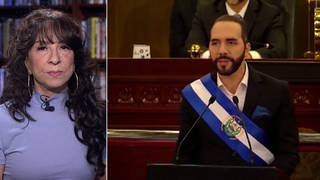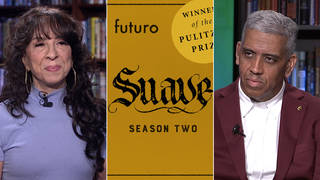
Guests
- John Lewisformer 17-term Georgia congressmember and a leader of the civil rights movement who died July 17, 2020.
As the United States mourns the loss of civil rights icon and 17-term Democratic Congressmember John Lewis, we feature his 2012 in-studio interview, when he tears up remembering the historic 1965 Selma to Montgomery march he helped lead in 1965 as a 25-year-old man, when he was almost beaten to death by police in what came to be called “Bloody Sunday” and helped push the country toward adopting the Voting Rights Act. “They came toward us, beating us with nightsticks and bullwhips, trampling us with horses,” he told Democracy Now! “All these many years later, I don’t recall how I made it back across that bridge to the church.”
Transcript
AMY GOODMAN: The nation is mourning the loss of civil rights icon, 17-term Democratic Congressmember John Lewis, whose legacy of freedom fighting and justice seeking stretched from the Jim Crow era to the Black Lives Matter movement. Lewis died Friday at the age of 80. He was diagnosed in December with pancreatic cancer.
John Lewis was born in Alabama to sharecroppers. He went on to become the youngest of the so-called Big Six who addressed the 1963 March on Washington, was ultimately elected in 1986 to be the congressional representative for his home state of Georgia, a post he never left. During the civil rights movement, Lewis marched side by side with Dr. Martin Luther King, helped found and served as chair of the Student Nonviolent Coordinating Committee, and helped organize the Freedom Rides. He was arrested more than 40 times protesting segregation.
As a mentor to those who followed in his footsteps, Lewis was known for encouraging them to, quote, “get in good trouble, necessary trouble.” In an interview last month, Lewis said the video of George Floyd’s death at the hands of Minneapolis police was, quote, “so painful, it made me cry,” he said, and that he was inspired by how it had sparked a new movement to end racial injustice. Congressmember Lewis made his final public appearance in June at the street near the White House that’s now named Black Lives Matter Plaza, where the words “Black Lives Matter” are painted in 35-foot yellow letters.
Former President Barack Obama said Saturday he hugged Lewis at his inauguration in 2009 and, quote, “told him I was only there because of the sacrifices he made.”
Meanwhile, President Trump waited more than 14 hours to tweet, after he had tweeted some 40 times, that he was, quote, “Saddened to hear the news of civil rights hero John Lewis passing,” and “Melania and I send our prayers to he and his family.”
Flags have been lowered to half-staff at the Capitol and the White House, and in Atlanta, where Mayor Keisha Lance Bottoms ordered the flags lowered to half-staff indefinitely.
Well, today we bring you an extended excerpt of my interview in 2012 with Congressmember John Lewis. He walked into our studio alone here in New York City, after the release of his book, Across That Bridge: Life Lessons and a Vision for Change. I began asking Congressmember John Lewis about the Selma to Montgomery march he helped lead in 1965 as a 25-year-old man, when he was almost beaten to death by police in what came to be called “Bloody Sunday.”
REP. JOHN LEWIS: On March 7, 1965, a group of us attempted to march from Selma to Montgomery, Alabama, to dramatize to the nation that people wanted to register to vote. One young African American man had been shot and killed a few days earlier, in an adjoining county called Perry County — this is in the Black Belt of Alabama — the home county of Mrs. Martin Luther King Jr., the home county of Mrs. Ralph Abernathy, the home county of Mrs. Andrew Young. And because of what happened to him, we made a decision to march.
In Selma, Alabama, in 1965, only 2.1% of Blacks of voting age were registered to vote. The only place you could attempt to register was to go down to the courthouse. You had to pass a so-called literacy test. And they would tell people over and over again that they didn’t or couldn’t pass the literacy test. On one occasion, a man was asked to count the number of bubbles on a bar of soap. On another occasion, a man was asked to count the number of jellybeans in a jar. There were African American lawyers, doctors, teachers, housewives, college professors flunking this so-called literacy test. And we had to change that, so we sought to march.
And we got to the top of the bridge. We saw a sea of blue — Alabama state troopers — and we continued to walk. We came within hearing distance of the state troopers. And a man identified himself and said, “I’m Major John Cloud of the Alabama state troopers. This is an unlawful march. It will not be allowed to continue. I give you three minutes to disperse and return to your church.” And one of the young people walking with me, leading the march, a man by the name of Hosea Williams, who was on the staff of Dr. Martin Luther King Jr., said, “Major, give us a moment to kneel and pray.” And the major said, “Troopers, advance!” And you saw these guys putting on their gas masks. They came toward us, beating us with nightsticks and bullwhips, trampling us with horses.
I was hit in the head by a state trooper with a nightstick. I had a concussion at the bridge. My legs went out from under me. I felt like I was going to die. I thought I saw Death. All these many years later, I don’t recall how I made it back across that bridge to the church. But after I got back to the church, the church was full to capacity, more than 2,000 people on the outside trying to get in to protest what had happened on the bridge. And someone asked me to say something to the audience. And I stood up and said something like: “I don’t understand it, how President Johnson can send troops to Vietnam but cannot send troops to Selma, Alabama, to protect people whose only desire is to register to vote.” The next thing I knew, I had been admitted to the local hospital in Selma.
AMY GOODMAN: Explain that moment where you decided to move forward, because I don’t think the history we learn records those small acts that are actually gargantuan acts of bravery. Talk about — I mean, you saw the weapons the police arrayed against you. What propelled you forward, Congressmember Lewis?
REP. JOHN LEWIS: Well, my mother, my father, my grandparents, my uncles and aunts, and people all around me had never registered to vote. I had been working all across the South. The state of Mississippi had a Black voting age population of more than 450,000, and only about 16,000 were registered to vote. On that day, we didn’t have a choice. I think we had been tracked down by what I call the spirit of history, and we couldn’t — we couldn’t turn back. We had to go forward. We became like trees planted by the rivers of water. We were anchored. And I thought we would die. I first thought we would be arrested and go to jail, but I thought it was a real possibility that some of us would die on that bridge that day, after the confrontation occurred. I thought it was the last protest for me. But somehow and someway, you have to keep going. You go to a hospital, you go to a doctor’s office, you get mended, and you get up and try it again.
AMY GOODMAN: So what was the next act you engaged in?
REP. JOHN LEWIS: Well, we continued to organize, continued to try to get people registered. We went to federal court, testified, to get an injunction against Governor George Wallace and the Alabama state troopers. And the federal court said that we had a right to march from Selma to Montgomery. President Johnson spoke to the nation and condemned the violence in Selma, introduced the Voting Rights Act. And that night, he made one of the most meaningful speeches that any American president had made in modern times on the whole question of civil rights and voting rights. He condemned the violence over and over again, and near the end of the speech he said, “And we shall overcome. We shall overcome.” We call it the “We Shall Overcome” speech.
I was sitting next to Dr. Martin Luther King Jr. as we listened to President Johnson. I looked at Dr. King. Tears came down his face. He started crying. And we all cried a little when we heard the president saying, “We shall overcome.” And Dr. King said, “We will make it from Selma to Montgomery, and the Voting Rights Act will be passed.” Two weeks later, more than 10,000 of us, people from all over America, started walking from Selma to Montgomery. And by the time we made it to Montgomery five days later, there were almost 30,000 Black and white citizens — Protestant, Catholic, Jewish, men, women, young people. It was like a holy march. And the Congress debated the act, passed it, and on August 6, 1965, President Lyndon Johnson signed it into law.
AMY GOODMAN: We’ll be back with my interview with 17-term Congressmember John Lewis in 30 seconds.










Media Options